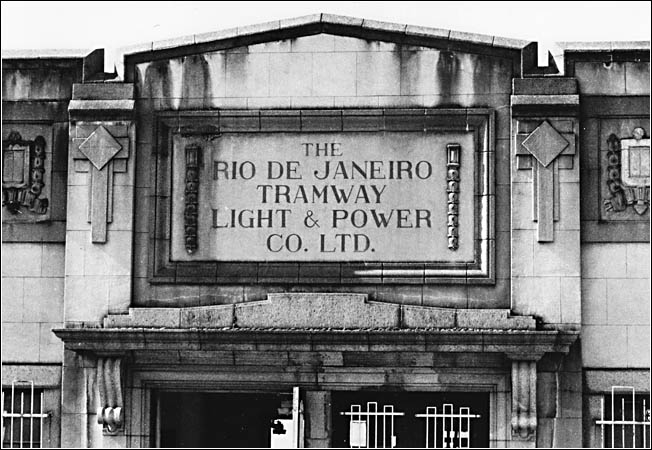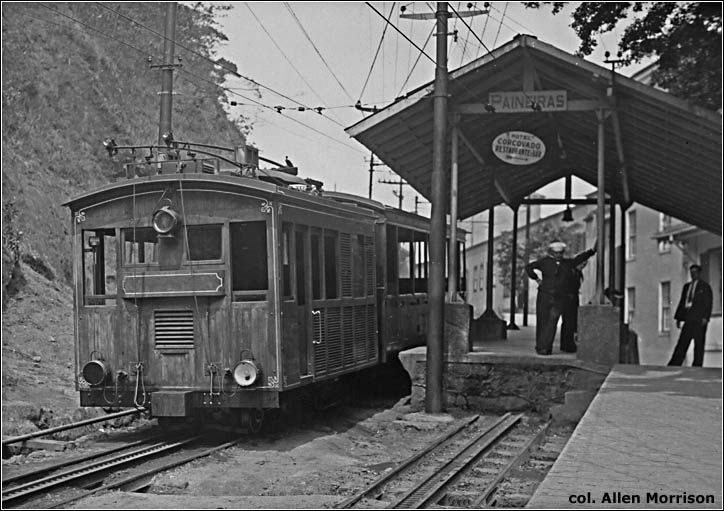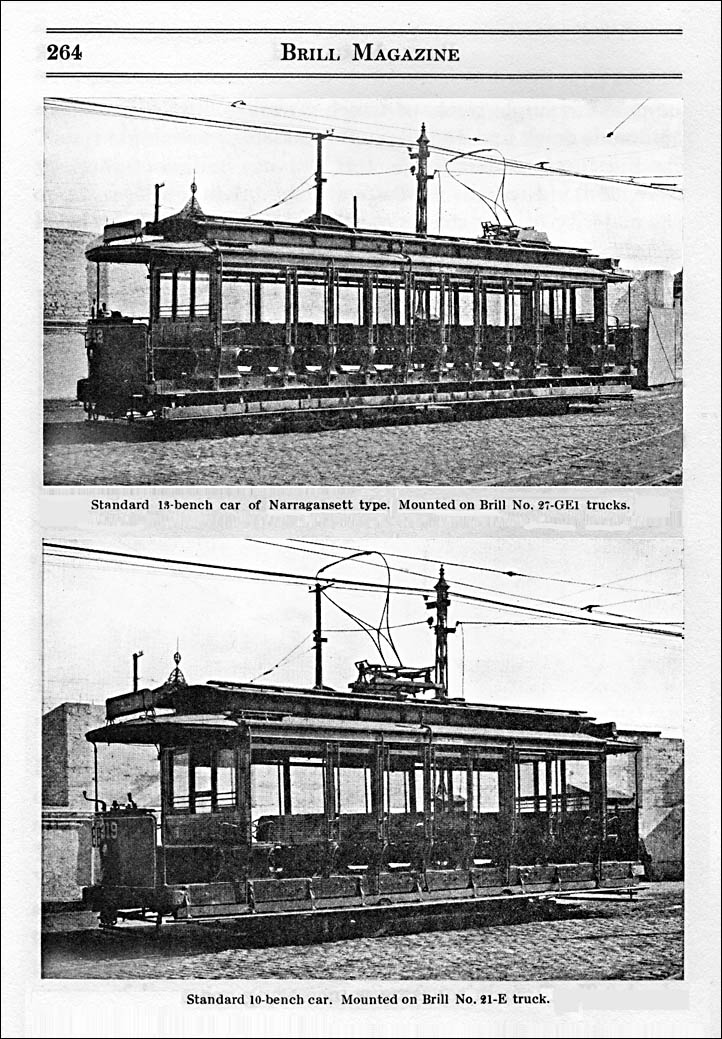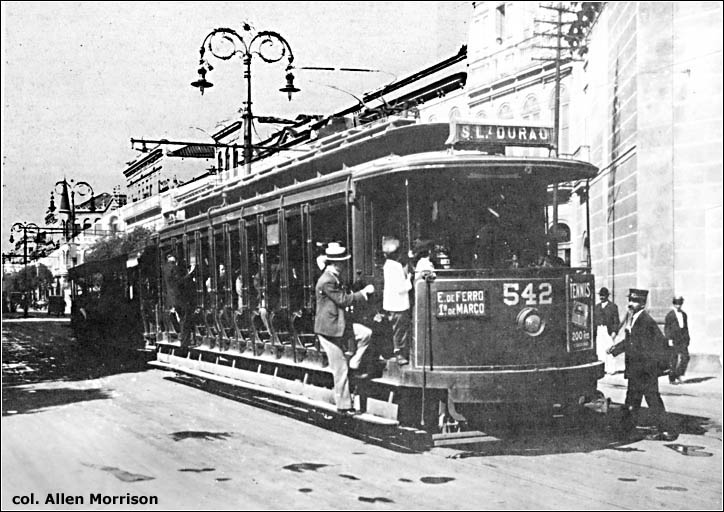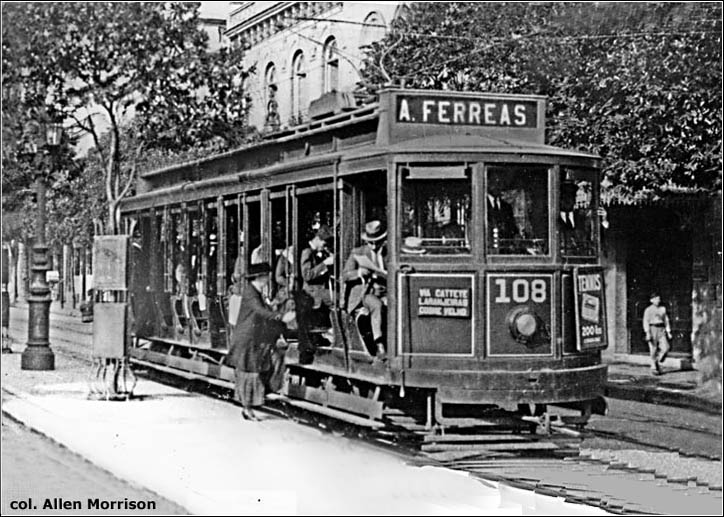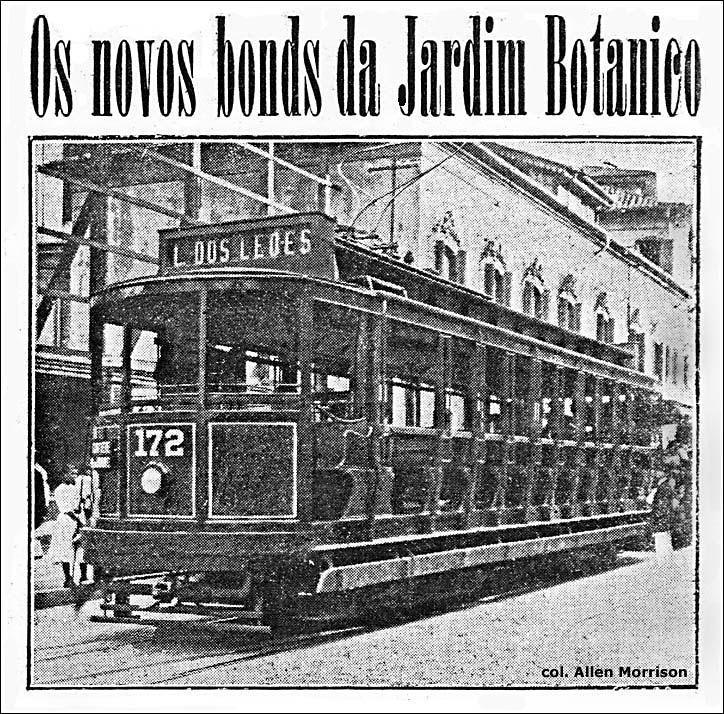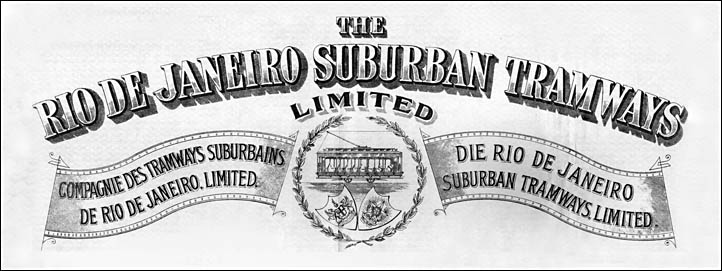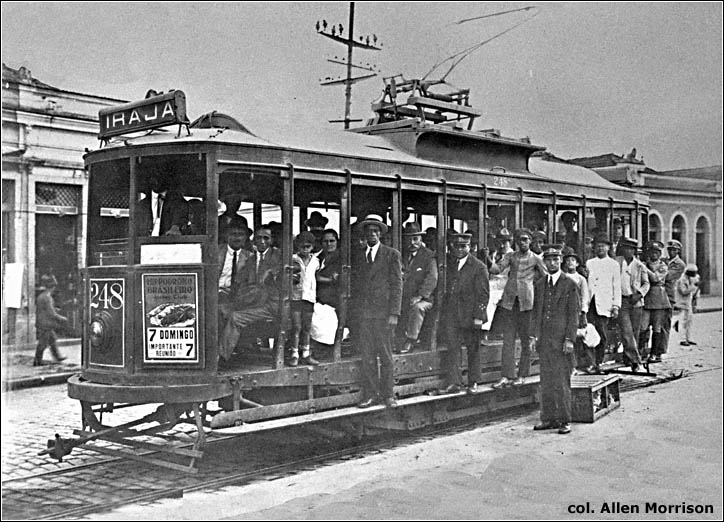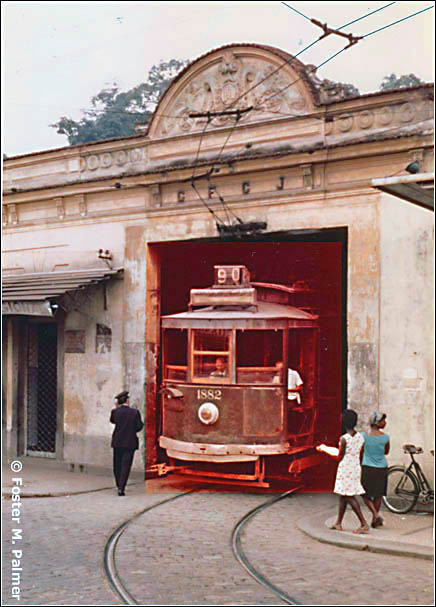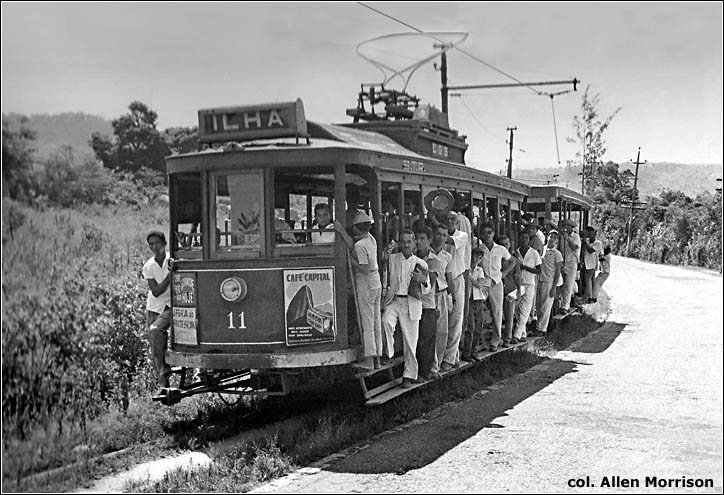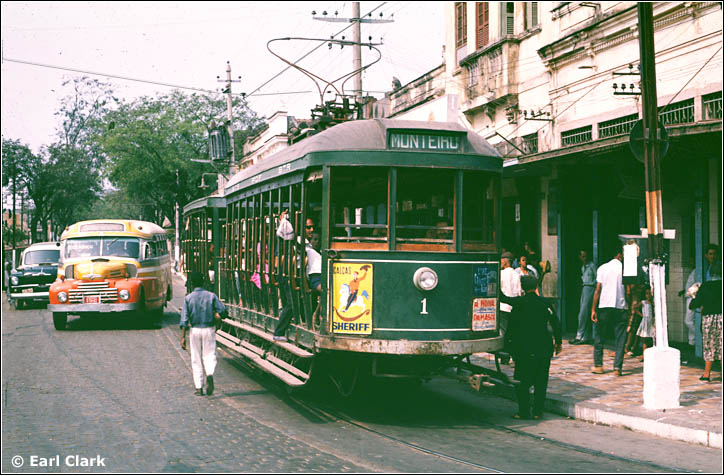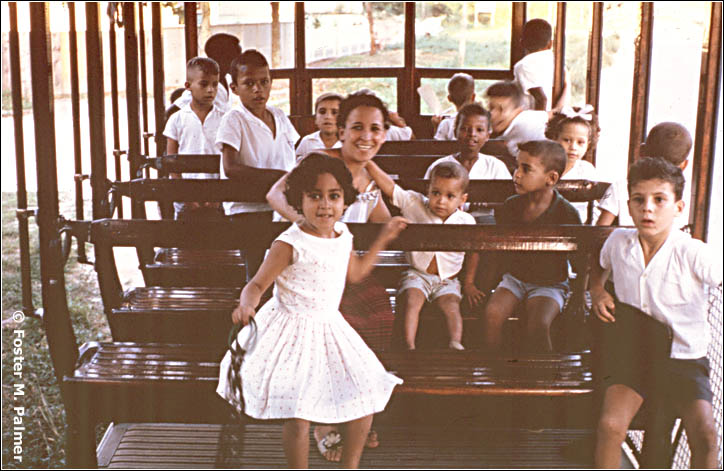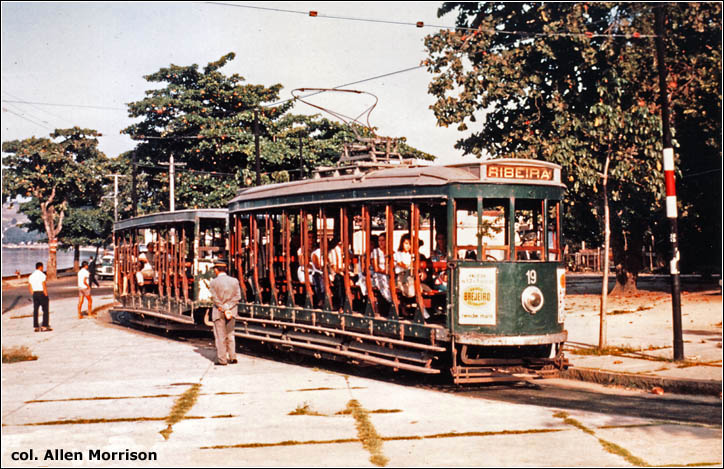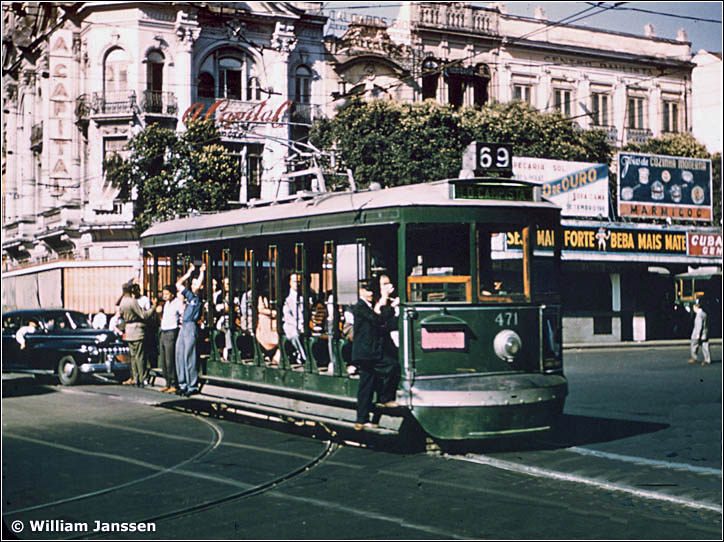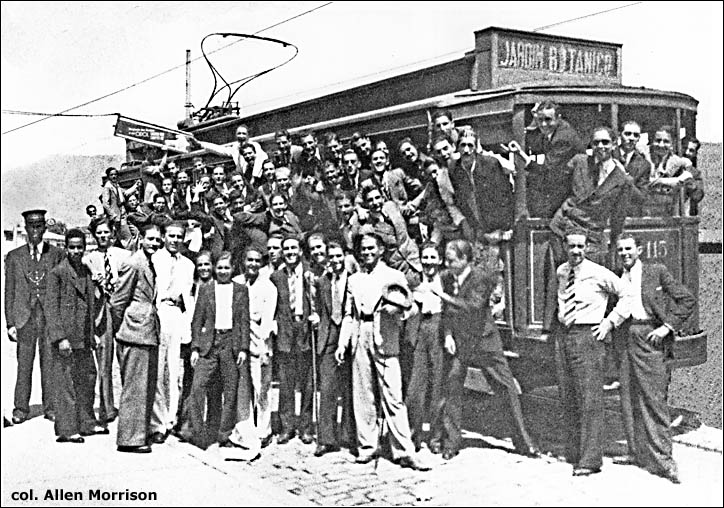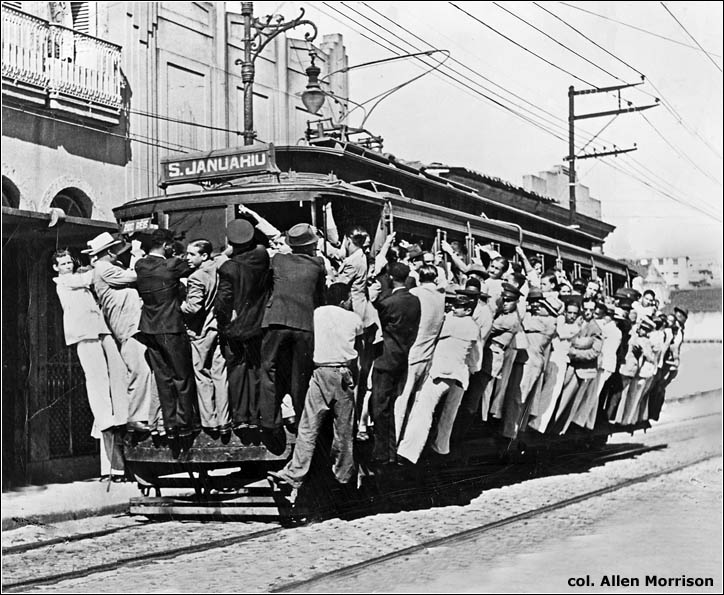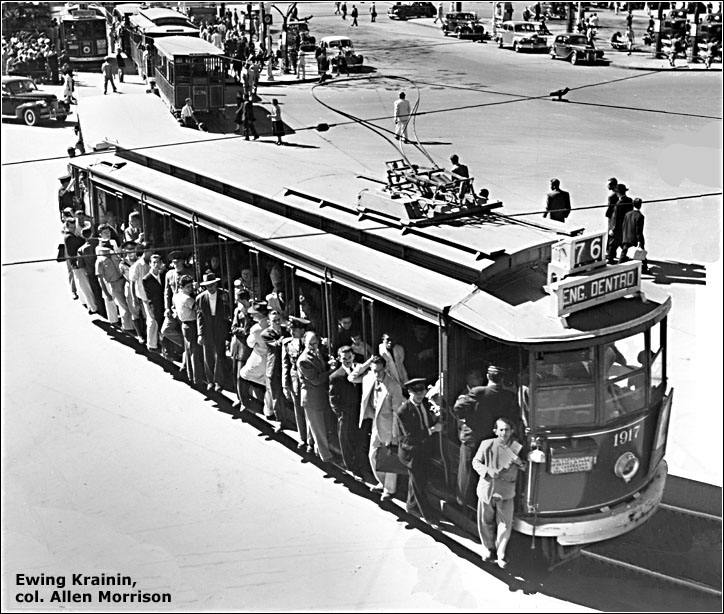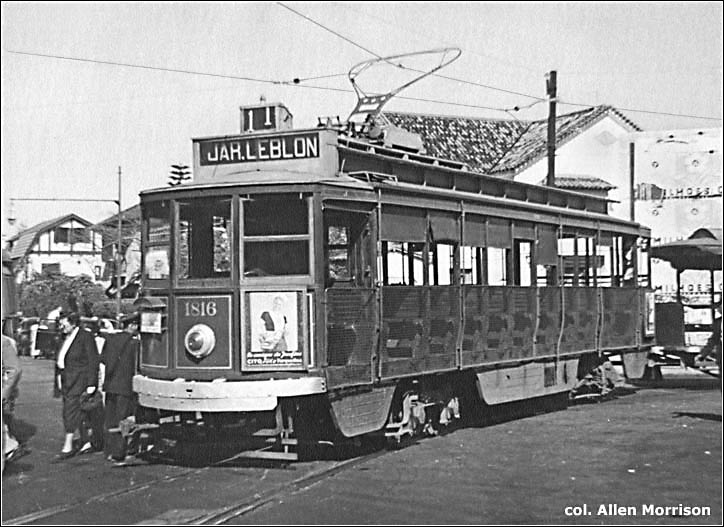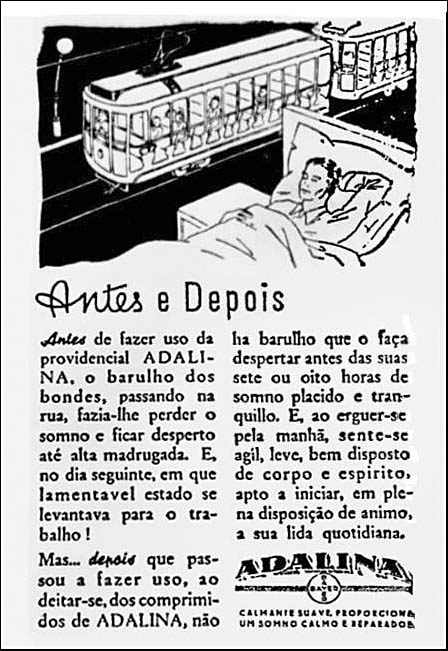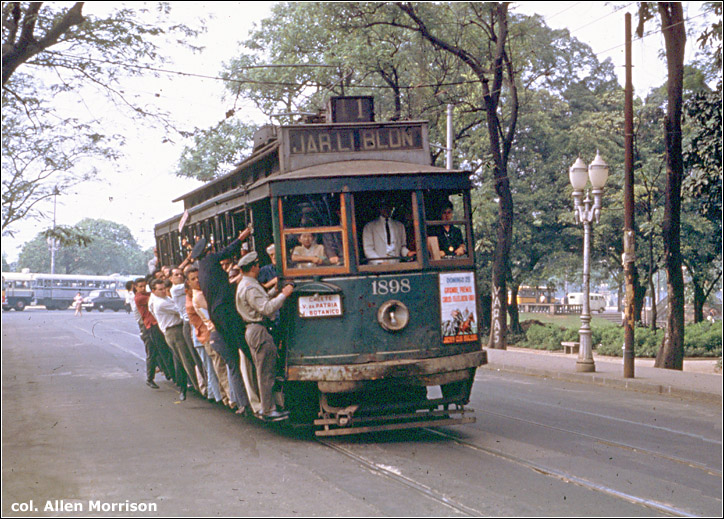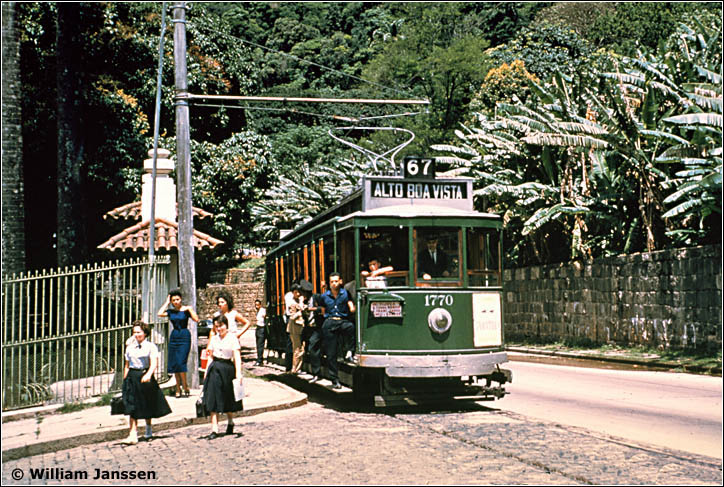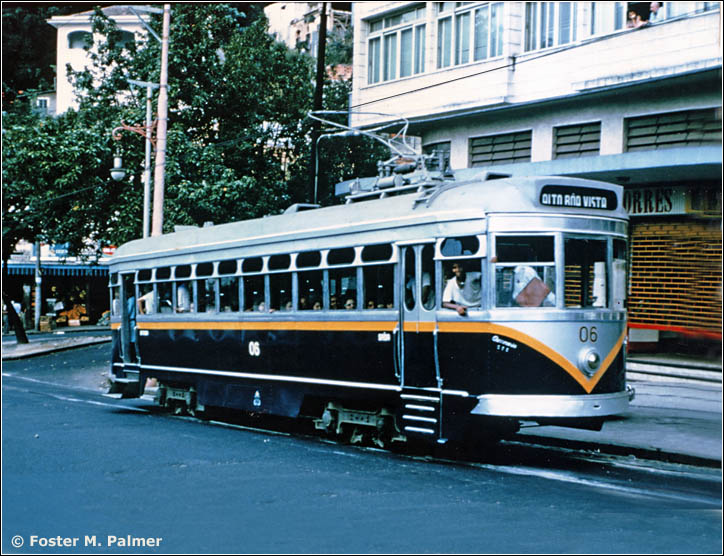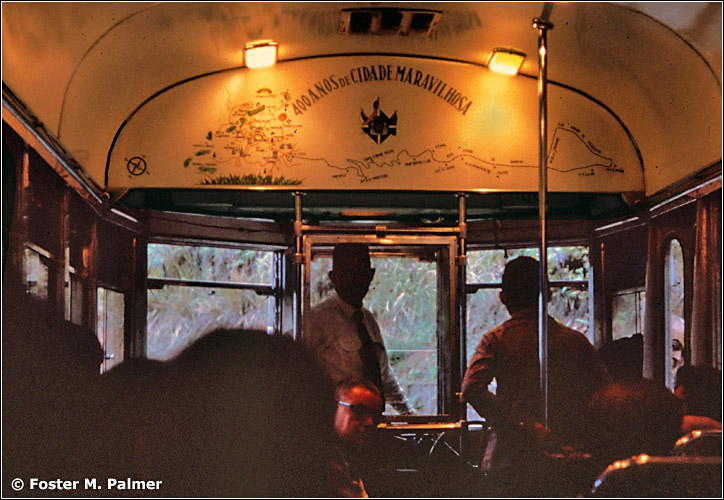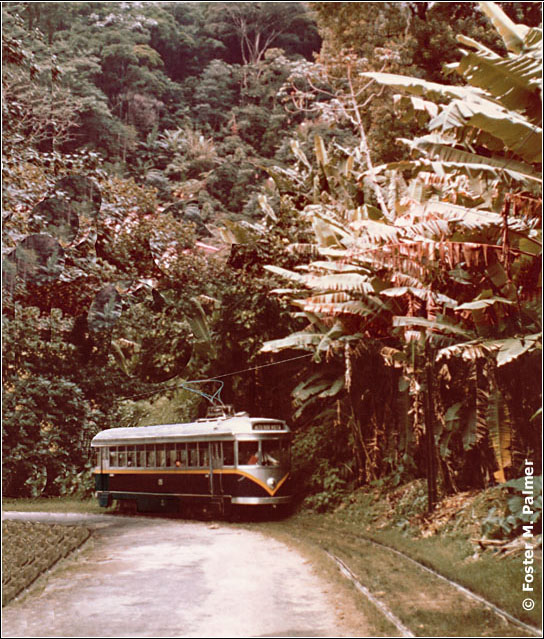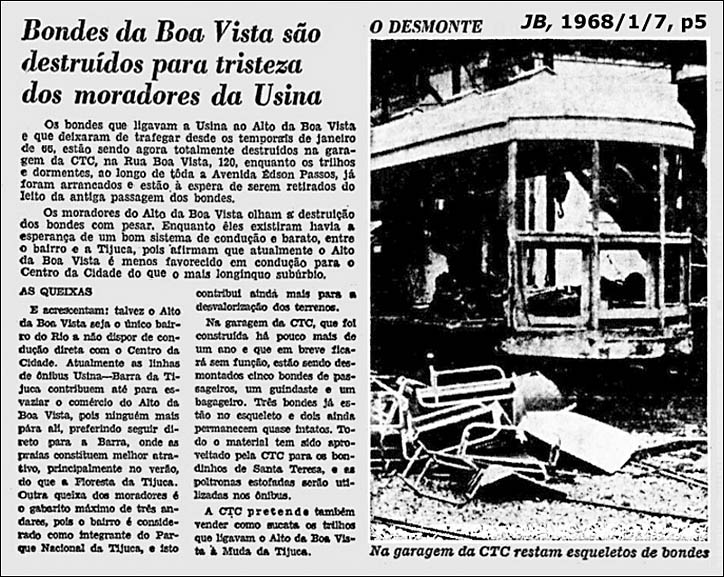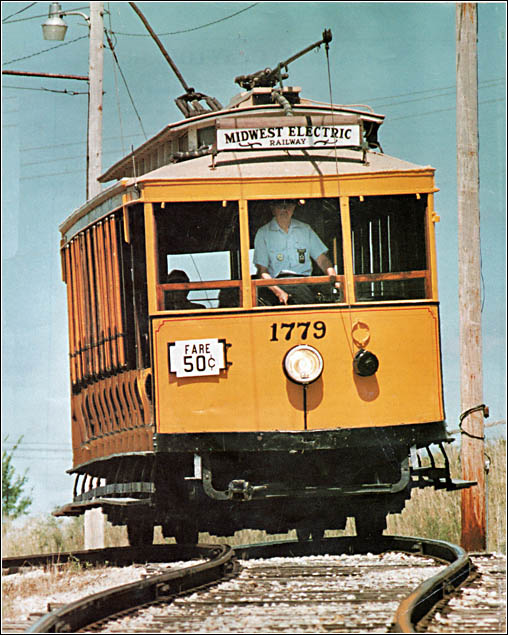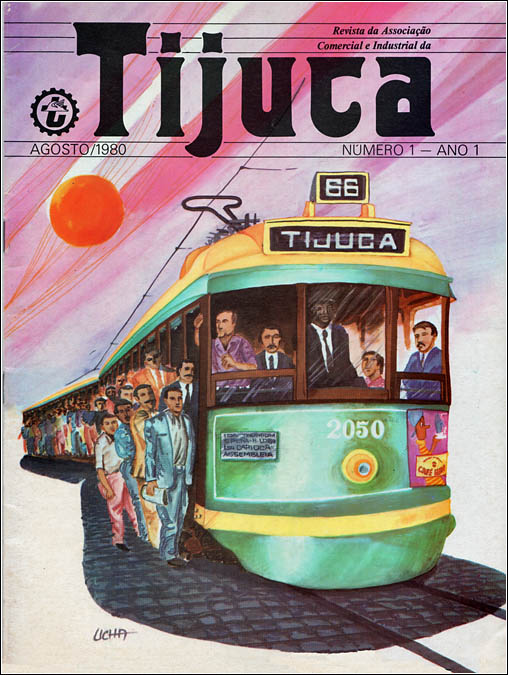RIO DE JANEIRO
75 Photographs of Tramway History
from the collection of
Allen Morrison
| This is an illustrated survey of tramway development in Rio de
Janeiro, Brazil, showing images that did not appear in my book The Tramways of Brazil or on the pages indexed at Electric Transport in Latin America. Part 3 (of 3): 1910-1967
Rio
de Janeiro Tramway, Light & Power Company was founded in Ottawa by a group of
Canadian and U.S. industrialists on 9 July
1904.
(They
had founded São Paulo Tramway, Light & Power five years
before.) RJTL&P built a power plant at Ribeirão das
Lajes in 1906 and in 1907 purchased the Vila Isabel, São
Cristóvão and Carris Urbanos tramway systems, as well as
Rio's
telephone company and gas works. It did not acquire the Jardim
Botânico or Santa Teresa tramways. Here is the entrance to one of its buildings [col. AM]:
"A
Light" (The Light), as RJTL&P
was called by Brazilians, ordered an electric passenger tram from
J. G. Brill in Philadelphia in 1905, but thereafter imported only
trucks and motors from the United States. Ten 10-bench electric cars
came from Brush Electrical in England in 1907 and 50 similar units from
United Electric in England in 1908. RJTL&P built 50 10-bench trams in its Vila Isabel shops in 1908-1909, and in the same
period purchased 13 10-bench cars and 8 13-bench
models – the city's first 4-axle trams – from Trajano de Medeiros & Cia. [col. AM]: 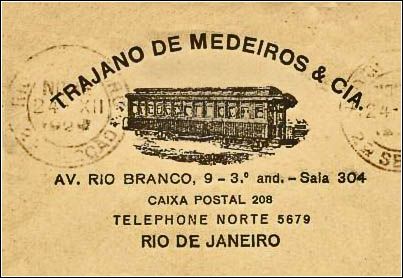 RJTL&P built its first 13-bench tram in 1909 and thereafter made all its own passenger equipment. On 1 January 1910 Rio de Janeiro Tramway, Light & Power had 213 passenger motor cars, 210 passenger trailers and 70 electric freight vehicles running on 221 km of track in the Zona Norte and the downtown area of the city [see map]. By 1912 the number of passenger motor cars had increased to 340. In addition to street railways, RJTL&P also purchased and electrified the 3.8 km Corcovado rack railway that climbs to the Christ statue overlooking the city. The four new locomotives, built by Schweizerische Lokomotiv- und Maschinenfabrik ("SLM") in Switzerland, used 3-phase supply and had twin trolley poles (that were lowered for the descent). The new line opened in 1910. The photograph shows Paineiras station at km 2.7 [col. AM]:
The Corcovado railway acquired new equipment in 1977
and today is the only electric passenger-carrying rack line in the western
hemisphere. An article in the September 1912 issue of Brill Magazine, published
by the tram builder in Philadelphia, showed Rio's two basic models. The article explained that only the
trucks on the vehicles came from Brill [col. AM]:
Here is a
13-bench model running on the RJTL&P system [col. AM]:
Ferro-Carril do Jardim Botânico acquired similar cars with
enclosed platforms. It is uncertain whether this 12-bench model was built by Trajano
de Medeiros, RJTL&P or, eventually, by Jardim Botânico itself
[col. AM]:
The illustration below was part of an article that appeared in A Notícia
on 12 February 1913. The article (typically) tells everything about the
tram except who built it. Note the old spelling of the word "bondes" [col. AM]:
Incredibly, amid all the electric activity, a new English company inaugurated a 5.7 km horsecar
line, between Madureira railroad station and Irajá, on 28 September 1911 [see map]. This heading on a stock
certificate notes the name in English, French and
German...but not Portuguese [col. AM]:
RJTL&P purchased RJST and electrified the line in 1928. The photo below
was taken at the reopening on 12 October of that year. The tram
is second-hand from the Ferro Carril do Jardim Botânico
[col. AM]:
In 1911 Light
also acquired and electrified the two Jacarepaguá
horsecar lines that began at Cascadura railroad station (near Madureira) [see map].
Note the initials of the Companhia Ferro Carril Jacarepaguá over
the door of the tram garage. This photograph was taken in 1965, shortly
before the line closed [Foster M. Palmer]:
One
of the favorites of every rail enthusiast was the tramway system
centered at Campo Grande railroad station 20 km west of Cascadura.
Campo Grande is physically separated from Rio by a mountain range, but
since both were in the former Distrito Federal it is considered part of
Rio de Janeiro today. The horsecar line that opened in 1894 was electrified in
1917 with second-hand trams from Jardim Botânico, similar to
those seen above on the Irajá line. Campo Grande's three electric
lines ran mostly side-of-the-road. A ride on the 20 km Ilha line took
two hours. (There is no "ilha" (island); the name here is a corruption of William.)
[col. AM]:
A different style tram exchanges passengers at the Campo Grande railroad station in September 1963. Monteiro was the tram depot [Earl Clark]:
Children of all ages on a Campo Grande trail tram [Foster M. Palmer]:
The last tram line to open was a completely new electric operation, without animal ancestry, on Ilha do Governador in Guanabara
Bay. The Companhia Melhoramentos da
Ilha do Governador opened the 7 km route, between the ferry terminal
at Ribeira and Bananal, on 4 October 1922 [see map]. The equipment chosen was the
same second-hand Jardim Botânico model used on the Irajá
and Campo
Grande lines. The vehicle shown in the photograph has been remodeled [col. AM]:
RJTL&P
also remodeled some of its city cars. Location is Praça
Tiradentes – where Rio's first tram line began in 1859 and where
the new light rail line passes today [see map] [William Janssen]:
Extra-long,
baggy trousers were the style in the 1940s, but why are these men
wearing jackets and ties to visit the Botanical Garden? [col. AM]:
The
passengers on this tram are not celebrating. The vehicle is coming
forward. How can the motorman see? He even seems to have lowered his
window blind! How does the conductor collect fares? [col. AM]:
Praia Vermelha is the beach, and district, below Sugar Loaf Mountain [Pan American World Airways, col. AM]:
Well-dressed
office workers on a majestic tram in the 1940s. Location is
Praça Duque de Caxias near the railroad station. Only men hanged
onto the sides
of trams. The women stayed inside [col. AM]:
This
is the peaceful terminus of Jardim Botânico's Leblon line. It
served primarily Leblon, but then turned east and actually ended in
Ipanema [see map]. One side
of the car has been screened for safety [col. AM]:
2561
is headed for Praça General Osório in Ipanema [see map]. Rio was the world capital of open trams. It had more than any other
city and a scene like this was never duplicated anywhere else [Carl Frank, col.
AM]:
|
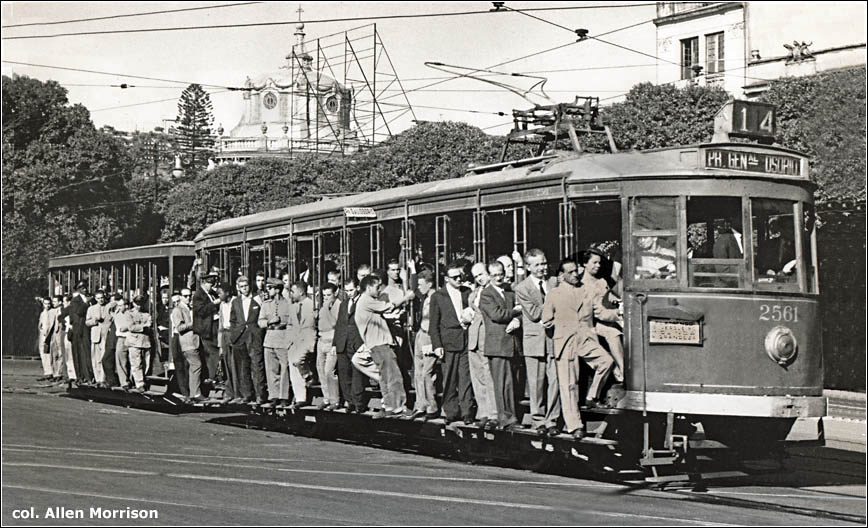
|
The following
Bayer medication claimed that it helped residents sleep when they were bothered by "o barulho dos bondes, passando na
rua" – the noise of trams passing in the street [col. AM]:
After
1937 all trams of the Jardim Botânico company – the routes
south to Botafogo, Copacabana, Ipanema, etc. – terminated at a
block-long shelter on Av. Almirante Barroso called Tabuleiro da Baiana.
The photograph shows a tram arriving from Rua 13 de Maio on the
left, another turning onto Rua Senador Dantas on the right [col.
João Diniz]:
The end began in the 1960s. On 31 December 1960 the Ferro-Carril do Jardim Botânico, which had originated the tramway industry in Brazil, passed out of existence. Its trams were operated temporarily by a municipal agency. The motormen and conductors still wore uniforms, but the vehicles and rails were no longer maintained [col. AM]:
The last trams in the Zona Sul – Copacabana, Ipanema, Leblon – ran on 21 May 1963. The new Companhia de Transportes Coletivos ordered 200 trolleybuses from Italy and blanketed the city with trolleybus lines. CTC absorbed all the city's remaining tram lines on 1 January 1964 and quickly eliminated them from the Zona Norte [see map]. In addition it closed the Ilha do Governador line on 10 April 1965, the Jacarepaguá lines on 10 January 1966, and the entire Campo Grande system on 31 October 1967. The only tram lines remaining after the latter date were those on Santa Teresa hill and the isolated line between Tijuca and Alto da Boa Vista – which had been the city's first electric line 75 years before! This picture was taken in happier days – about 1957 [William Janssen]:
1965
marked the 400th anniversary of the city's founding and, among the
celebrations, the government promoted its two most picturesque tram
lines. The Santa Teresa system was rehabilitated and ten 13-bench trams
were rebuilt closed for the Alto da Boa Vista line [see map] [Foster M. Palmer]:
The
interior of each car had upholstered seats, a map of the line above the motorman, and
the slogan of the anniversary celebration: "400 Years of the
Marvelous City" [see other photos of the line] [Foster M. Palmer]:
Tram 06 winds its way up the mountain through the luxuriant foliage of Tijuca National Park [Foster M. Palmer]:
But visitors wanted Rio's famous open cars. And to experience the new service they had
to find their way to Praça da Bandeira, far from the tourist district, where the line began. Hurricanes in January 1966 and, incredibly, again in January 1967 caused landslides and brought down trees and overhead wire throughout town. Alto da Boa Vista tram service was shortened. Instead of Praça da Bandeira, the route began thereafter at the loop in Usina, even farther from town [see map]. This was exactly where the line began when it opened in 1898! Track and wire were removed from Rua Conde de Bonfim and a new shelter was built for the cars at the other end of the line in Alto da Boa Vista. Tramway operation continued but was sporadic, and, according to newspapers, finally ended on 21 December 1967. With no way to return to the city, a half
dozen trams were stranded at the ABV terminus, which was located at the
corner of Rua Boa Vista and Estrada do Açude. And that is where
they were destroyed. The following article explains that some of the
parts were transferred to Santa Teresa trams and the upholstered seats
were placed on buses. CTC sold the rails for scrap. [The text
erroneously reports that tram service ended after the 1966 storm.] [Jornal do Brasil, 7 January 1968, p. 5]:
Brazil's loss was America's gain. The other event in 1965 was the sale of a dozen Rio trams to tramway museums in the United States: old 2-axle cars 322 and 441, and old 4-axle cars 1718, 1719, 1758, 1774, 1779, 1794, 1850, 1875, 1887 and 1889. Most of them still run in the U.S. today. Number 1779 is shown at the Midwest Old Threshers Museum in Mt. Pleasant, Iowa, about 300 km/200 miles west of Chicago [col. AM]:
It wasn't long before Brazilians realized
what they had lost and had "saudades" (nostalgia) for the fond traditions of the
past. Rio without its "bondes" (trams) was unthinkable and tributes
began to appear, and still appear today, in magazines and newspapers
all over. This one was appropriately published where it all began 121
years before [col. AM]:
The former Ferro-Carril Carioca trams still run today from Largo da Carioca over the aqueduct to the hills of Santa Teresa [see map]. The cog railway still carries passengers from Cosme Velho to "Cristo Redentor" atop Corcovado Mountain. And Rio recently opened the first sections of its extraordinary new VLT - light rail system.
Return to Part 2 of Rio de Janeiro Tramway History
For more information about Rio's tramway
history see the online edition of The Tramways of Brazil and two
articles about the Ferro-Carril Carioca: The Santa Teresa Tramway and Santa Teresa Tramway Vehicles.
Other sources of information: Noronha Santos, Meios de Transporte no Rio de Janeiro, published in Rio in 1934: vol. 1 (de 2), pp. 235-240 e 255-475
C. J. Dunlop, Apontamentos para a História dos Bondes no Rio de Janeiro, published in Rio in 1953 C. J. Dunlop, Subsídios para a História do Rio de Janeiro, published in Rio in 1957; second edition, 2008 Marcus Vinicius Kelli Os Irmãos Röhe e o Mercado de Veículos na Cidade do Rio de Janeiro (1831-1883) Helio Ribeiro Bondes da Light do Rio de Janeiro Elaborate website about the city's huge standard-gauge tramway system O Rio que o Rio não vê The Villa Guarany tram frieze
======== In
addition to the photographers and publications noted above, the author would like to express his
gratitude to Paulo Pacini and Helio Ribeiro of Rio de Janeiro for their assistance in the
preparation of these pages.
If you have comments, criticism or suggestions, |
